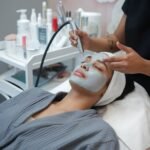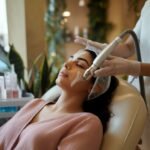How to Prevent Stretch Marks During Pregnancy and Reduce Pregnancy Scars
- Home
- Mole, Wart & Skin Tag Removal
- how to prevent stretch marks during pregnancy

To prevent stretch marks during pregnancy, maintaining skin hydration through lotions containing hyaluronic acid is essential. A balanced diet rich in vitamins C, E, zinc, and protein supports collagen production, enhancing skin elasticity. Gradual weight gain and regular exercise also mitigate stretch mark risks by promoting healthy skin. For those looking to naturally get rid of stretch marks, post-pregnancy treatments like laser therapy can reduce scars through collagen stimulation. Understanding these strategies can further enhance one’s approach to minimizing pregnancy-related skin changes—be sure to learn all about pregnancy stretch to make informed skincare decisions throughout your journey.
Key Takeaways
- Maintain skin hydration with lotions containing hyaluronic acid to prevent stretch marks.
- Follow a balanced diet rich in vitamins C, E, zinc, and protein for collagen support.
- Use humidifiers to prevent skin dryness and enhance skin elasticity.
- Consider laser therapy or microdermabrasion for post-pregnancy stretch mark reduction.
- Engage in regular exercise and gradual weight gain to reduce stretch mark risk.
How Do Stretch Marks Appear During Pregnancy?
During pregnancy, the rapid expansion of skin and hormonal changes predispose women to the development of pregnancy stretch marks, or striae gravidarum.
Stretch marks are a common occurrence, typically emerging during the second or third trimester when the skin undergoes significant stretching to accommodate the growing fetus.
Genetic predisposition, age, and pre-pregnancy body mass index are among the factors that can further increase an individual’s susceptibility to developing these dermal scars. For expectant mothers seeking tips to prevent stretch marks, maintaining skin hydration, eating a nutrient-rich diet, and using doctor-recommended topical treatments may offer some benefits.
Why Are Pregnant Women Prone to Stretch Marks?
As the skin stretches rapidly due to the growing fetus, pregnant women are particularly susceptible to developing stretch marks, medically known as striae gravidarum. While not all women will develop stretch marks, those who do often experience significant skin changes caused by pregnancy hormones and weight gain. These hormonal fluctuations, including elevated levels of estrogen and glucocorticoids, contribute to the weakening of collagen and elastin fibers within the dermal layer.
As a result, the skin’s elasticity diminishes, increasing the risk of stretch marks. Conversely, some women are less prone to stretch marks due to factors such as genetics and skin type. The accumulation of pregnancy weight further exacerbates this condition, especially in areas such as the abdomen, breasts, and thighs.
Consequently, pregnancy stretch marks appear as the skin’s capacity to accommodate rapid expansion is compromised, making pregnant women particularly prone to stretch marks.
When Do Stretch Marks Appear in Pregnancy?
Although the exact timing can vary, stretch marks typically begin to appear during the second and third trimesters of pregnancy. This phenomenon is associated with rapid skin stretching due to increasing pregnancy weight and changes in hormone levels during pregnancy, which can compromise skin elasticity.
As the abdomen expands, the dermis may not withstand the mechanical stress, causing pregnancy stretch marks to form. These stretch marks often develop as red or purple lines on the skin, though they may later fade to a lighter color.
While stretch marks usually appear on the abdomen, they can also affect the thighs, hips, and breasts. Understanding when stretch marks appear enables expectant mothers to implement strategies to effectively prevent and treat stretch marks during pregnancy.
What Factors Increase the Risk of Stretch Marks?
Several intrinsic and extrinsic factors contribute to the increased risk of stretch marks during pregnancy. The rapid weight gain throughout your pregnancy is a primary factor, as skin cannot accommodate the quick expansion. Therefore, the best way to prevent stretch marks is to slowly gain pregnancy weight.
Hormones during pregnancy, such as increased levels of glucocorticoids, alter collagen production, weaken skin elasticity and facilitate the development of stretch marks. Pregnant women will notice stretch marks starting to appear in areas like the abdomen, breasts, and thighs, where the most pronounced changes occur.
Additionally, genetic predisposition plays a considerable role in the incidence of stretch marks. Consequently, managing pregnancy weight slowly and steadily may mitigate the likelihood of formation.
What Are the Best Ways to Prevent Stretch Marks During Pregnancy?
Effective prevention of stretch marks during pregnancy can be approached by maintaining skin hydration, utilizing specific topical formulations, and ensuring adequate nutritional intake.
Research indicates that regular application of emollients and creams containing ingredients such as hyaluronic acid and Centella asiatica may enhance skin elasticity.
Additionally, a diet rich in vitamins C, E, zinc, and protein supports collagen formation, which is essential in minimizing the risk of stretch mark development.
How Can You Keep Your Skin Hydrated?
Maintaining ideal skin hydration is an essential component in preventing stretch marks during pregnancy. Adequate skin moisture plays a critical role in enhancing skin elasticity, thereby reducing the likelihood of stretch marks forming.
To achieve maximum hydration, several scientifically validated methods can be employed:
- Regular application of hydrating lotions and creams: These products can help lock in moisture and maintain skin suppleness.
- Adequate water intake: Consuming sufficient fluids supports systemic hydration, benefiting skin elasticity.
- A diet rich in essential fatty acids: Incorporating foods like avocados and nuts can enhance skin’s moisture retention capabilities.
- Humidifier usage: Adding moisture to the air can prevent skin from becoming dry, especially in arid climates.
Each strategy contributes to maintaining the skin’s integrity and resilience during pregnancy.
Are There Specific Creams to Prevent Stretch Marks?
What role do topical applications play in the prevention of stretch marks during pregnancy? Topical treatments, particularly stretch mark creams, are a popular option for reducing stretch marks. These formulations aim to keep your skin moisturized and elastic, which may help prevent stretch marks. Scientific evidence suggests that consistent application of certain creams can reduce the appearance of pregnancy stretch marks. Ingredients such as hyaluronic acid, vitamin E, and cocoa butter are often cited in the best stretch mark prevention during pregnancy.
Ingredient | Function |
Hyaluronic Acid | Hydrates and maintains skin elasticity |
Vitamin E | Antioxidant that supports skin health |
Cocoa Butter | Moisturizes and softens the skin |
Centella Asiatica | Enhances collagen production |
Almond Oil | Nourishes and improves skin elasticity |
These treatments for stretch marks are widely available and may contribute to healthier skin.

What Role Does Nutrition Play in Stretch Mark Prevention?
Nutrition plays a pivotal role in the prevention of stretch marks during pregnancy by supporting skin health and elasticity. Essential nutrients guarantee the skin remains supple, aiding in stretch marks prevention.
A balanced diet, rich in specific vitamins and minerals, is vital for maintaining a healthy pregnancy and promoting skin resilience. Key nutritional strategies include:
- Zinc: Supports collagen production, enhancing skin elasticity.
- Vitamins C and E: Antioxidants that protect against skin damage and promote repair.
- Slow, steady weight gain: Helps the skin adapt gradually, reducing stretch mark risk.
- Hydration: Adequate fluid intake maintains skin moisture, improving its stretchability.
These nutritional elements collectively contribute to an extensive approach to prevent stretch marks, making dietary management a cornerstone of maternal skin care.
Can Be Reduce the Appearance of Stretch Marks After Pregnancy?
Postpartum stretch mark reduction can be approached through various treatments, including topical retinoids, laser therapy, and microdermabrasion, each demonstrating varying degrees of efficacy.
Scientific studies indicate that while home remedies such as cocoa butter and aloe vera are popular, they lack robust clinical evidence supporting their effectiveness in notably reducing stretch marks.
Individuals need to consult healthcare professionals to identify the most appropriate treatment based on skin type and the severity of the stretch marks.
How can stretch marks be effectively reduced through treatment?
Stretch marks, scientifically referred to as striae distensae, can be mitigated post-pregnancy through various evidence-based treatments.
Pregnancy stretch marks are usually a common, natural part of pregnancy, but several interventions can minimize their appearance. Clinicians employ multiple strategies to address stretch marks after pregnancy, aiming to improve the appearance of stretch marks and reduce their visibility.
Effective treatments include:
- Laser Therapy: This procedure stimulates collagen production to improve skin texture.
- Microdermabrasion: Gently removes dead skin cells to help diminish the visibility of stretch marks.
- Topical Retinoids: Prescription creams that enhance skin regeneration and collagen synthesis.
- Chemical Peels: Use of acids to remove the outer skin layer, promoting new growth.
These treatment modalities not only target prevention but also seek to reduce the appearance of stretch marks effectively.
How Effective Are Home Remedies in Stretch Mark Reduction?
While medical treatments offer structured approaches to reducing stretch marks, many individuals explore home remedies as potential adjuncts.
The effectiveness of natural remedies in preventing stretch marks during pregnancy and reducing the visibility of pregnancy scars is a subject of ongoing investigation. Expert tips suggest that consistent hydration and topical application of oils, such as almond or coconut, may help reduce stretch marks during pregnancy by improving skin elasticity, as stretch marks are a natural result of the skin’s rapid stretching.
Some anecdotal evidence supports the use of these methods to minimize the appearance of pregnancy stretch marks. However, clinical studies are limited, and results vary.
An increase in stretch marks is influenced by genetic factors, making prevention challenging. Consequently, while home remedies can be beneficial, they should not replace evidence-based medical treatments for ideal stretch mark reduction.
How Does Pregnancy Weight Affect Stretch Marks?
The correlation between pregnancy weight gain and stretch mark development is well-documented in scientific literature, indicating that rapid weight gain can greatly increase the likelihood of striae gravidarum.
Managing pregnancy weight through a balanced diet and regular physical activity may mitigate this risk by promoting gradual skin expansion, thereby reducing dermal tearing.
Health professionals often recommend individualized weight management plans to optimize maternal and fetal health while minimizing the formation of stretch marks.
Does Rapid Weight Gain Increase Stretch Mark Development?
Though often overlooked, rapid weight gain during pregnancy is a critical factor contributing to the development of stretch marks.
Scientific evidence suggests that significant and swift weight gain can cause skin to stretch beyond its elastic capacity, leading to the formation of stretch marks. These dermal tears, commonly known as pregnancy stretch marks, become noticeable when collagen fibers are disrupted.
The likelihood of people developing stretch marks increases proportionally with the rate of weight gain. To prevent pregnancy stretch marks effectively, it is essential to understand the underlying mechanisms.
Key factors include:
- Skin elasticity: Reduced elasticity can lead to easier tearing.
- Genetic predisposition: Genetic factors may dictate an individual’s susceptibility.
- Hormonal changes: Hormones can influence skin resilience.
- Nutritional status: Poor nutrition can exacerbate skin vulnerability.
How Can You Manage Pregnancy Weight to Help Prevent Stretch Marks?
Managing pregnancy weight effectively is vital in reducing the risk of stretch marks. Scientific consensus indicates that a balanced diet, emphasizing nutrient-rich foods, supports healthy weight gain and skin elasticity.
Gradual weight gain, as opposed to rapid increases, is associated with fewer stretch marks. Regular exercise contributes to this gradual gain and improves overall skin health.
Adequate hydration is important, as it enhances skin elasticity, potentially preventing stretch marks. Prenatal vitamins provide necessary nutrients that may support skin resilience.
In addition, pregnancy skincare, including the application of moisturizers, can maintain skin flexibility. Collectively, these strategies assist in managing pregnancy weight and help prevent stretch marks by maintaining ideal skin condition and minimizing excessive stretching, which leads to skin tearing.

Is There a Way to Prevent Stretch Marks During the Third Trimester?
During the third trimester, the skin undergoes significant changes due to rapid fetal growth and increased maternal weight, leading to heightened mechanical stress on the dermal layer. Many individuals develop stretch marks during growth spurts, making it important to prevent stretch marks by adopting an effective skincare regimen.
To maintain skin elasticity during this period, a regimen incorporating topical emollients rich in hyaluronic acid and retinoids has shown efficacy in supporting collagen synthesis and hydration.
Clinical studies suggest that consistent application of these agents may reduce the occurrence of stretch marks by enhancing the skin’s tensile strength and adaptability, indicating that preventing stretch marks may be achievable with proper skin care.
What Changes Occur in the Third Trimester That Affect Skin?
As the body undergoes significant physiological changes in the third trimester, the skin experiences increased tension and stretching, primarily due to the rapid growth of the fetus and the expansion of the abdomen, causing many individuals to experience stretch marks naturally.
This period is essential as women may develop stretch marks, which are linear scars resulting from skin changes that come with pregnancy. The increase in abdominal girth can lead to dermal tearing, making it challenging to prevent these marks entirely.
However, understanding these changes can aid in reducing their occurrence.
- Increased collagen breakdown: Collagen fibers weaken, leading to reduced skin integrity.
- Hormonal fluctuations: Elevated hormone levels can exacerbate skin sensitivity.
- Decreased skin elasticity: Reduced elasticity increases the likelihood of stretch marks.
- Enhanced blood flow: This may temporarily improve skin appearance but does not prevent scarring.
How Can You Maintain Skin Elasticity in Late Pregnancy?
Maintaining skin elasticity during late pregnancy may effectively prevent stretch marks. Scientific evidence suggests that enhancing skin elasticity may reduce the risk of getting stretch marks during this stage.
A multifaceted approach is recommended to maintain skin elasticity. Adequate hydration is vital, as it supports skin health and collagen production. Moisturizing the skin with products containing ingredients like hyaluronic acid and vitamin E can enhance elasticity, and in some cases, stretch marks may become less likely to form.
A balanced diet rich in vitamins C and E, along with zinc and stretch marks protein, supports collagen synthesis. These nutrients are essential for maintaining the skin’s structural integrity and may also reduce the visibility of stretch marks that do appear.
It’s important to note that stretch marks differ from cellulite, both in appearance and underlying causes. While stretch marks are a form of scarring due to skin stretching and tearing, cellulite is the result of fat deposits pushing through connective tissue beneath the skin.
Additionally, maintaining a steady weight gain can minimize excessive skin stretching. While no method guarantees prevention, these strategies may mitigate the likelihood of stretch marks during late pregnancy.
Conclusion
Stretch marks, common in pregnancy, result from rapid skin stretching and hormonal changes. Many women get stretch marks during pregnancy, especially in the third trimester, due to the skin’s reduced elasticity. While complete prevention may not be possible, strategies like maintaining a healthy weight, staying hydrated, and using topical treatments rich in hyaluronic acid and vitamin E can mitigate their appearance. Post-pregnancy treatments such as laser therapy and retinoids may reduce their visibility. Although genetics play a role, proactive skincare, especially during the third trimester, can minimize stretch mark development and improve skin elasticity.

Highly skilled cosmetologist at Tune Clinical Aesthetics, specializing in advanced skin and hair treatments.





